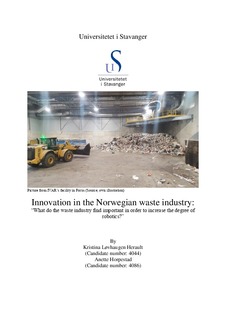| dc.description.abstract | Executive summary
This thesis addresses what the Norwegian waste industry find important in order to increase the degree of robotics, by looking into the companies’ value chain. Therefore, we find it interesting to look into RobotNorge’s robots, to find out if they are interesting choice for the waste industry. In order to uncover if RobotNorge’s products are suitable for the waste industry we choose a sub-question, “Does RobotNorge's robots fit into what the waste industry find important?”.
The background of the waste industry in Norway is to ensures collection, treatment and recycling of around 11-12 million tons of waste yearly and have a turnover for more than NOK 22 billion annually. The robotics industry in Norway however, have a low density of industry robots compared to other countries. An explanation is related to the composition of industries in Norway, as both of the manufacturing are related to the exploitation of oil and gas and fishing industries which play an important role in Norway.
We choose a qualitative research method in order to collect new and firsthand information through semi-structured interviews. The companies’ names are Norsk Gjenvinning AS (NG), Ragn-Sells AS, Westco AS, IVAR IKS, Romerike avfallsforedling IKS (ROAF) and Retura TRV. These are carefully selected based on their location in Norway.
Throughout the analysis, we look into the degree of robotics today which is based on the information we have collected though our interviews. There is only one company that is about to start using robots with AI in their production process, NG. However, ROAF, IVAR and NG also use Near Infrared (NIR) technology machines developed by TOMRA. This sensor-based sorting technology is the new modern method for recycling facility in waste industry. Additionally, according to all informants within both intercommunal and private companies, they indicate the robot would be most efficient to have within the production process, which will result in higher end product quality. The Norwegian waste industry have some barriers which is interesting in regards of implementation of robotics, such as price, requirements and regulations, and some informants mentioned a barrier with the robot’s software and functionality. Furthermore, the companies’ innovation focus is mainly through consultants, own research or observations from other companies.
The waste industry expects robotics technology to become better in the future which can help the industry to meet the environmentally friendly expectations from society. However, according to ROAF the robotics technology must be adapted in a larger selection than the existing solution. The robot technology must be combined and further developed both in the gripping function and appearance of the robot, the whole robot must be improved. Which creates an opportunity for the future.
We have found six important factors for the waste industry which are related to price of robotics, efficiency of robotics, quality of the end product (clarity), implementing options of robotics, experienced suppliers and access to knowledge. For both intercommunal and private companies’, the highest valued factor is quality of the end product (clarity). Secondary, for intercommunal is efficiency of robotics and for private is price of robotics. Thirdly, for intercommunal is implementing options of robotics and for private access to knowledge.
Answering our sub-question, RobotNorge’s product the FlexPicker is useful for smaller assembly lines to pick out light objects such as batteries, glass or HDPE. However, the FlexPicker is less suitable for private companies compared to the intercommunal companies since both financial point and waste type differ. Yet, RobotNorge have the possibility of creating custom made solutions for the different needs for each company as they have a large selection of different robot bodies to choose from at ABB. Still, the solutions are not optimal as it is time consuming and costs money.
The overall result shows the degree of robotics is expected to increase if the robot can meet the requirements such as higher clarity on the end product, higher efficiency, affordable price etc. This will result in competitive advantage for the waste industry and relief them from monotonous and some unsafe working tasks. However, the high uncertainty of how long period it’s going to take to accomplish the expected accuracy and capacity of robotics, lead to a barrier to implement robotics today. | nb_NO |

